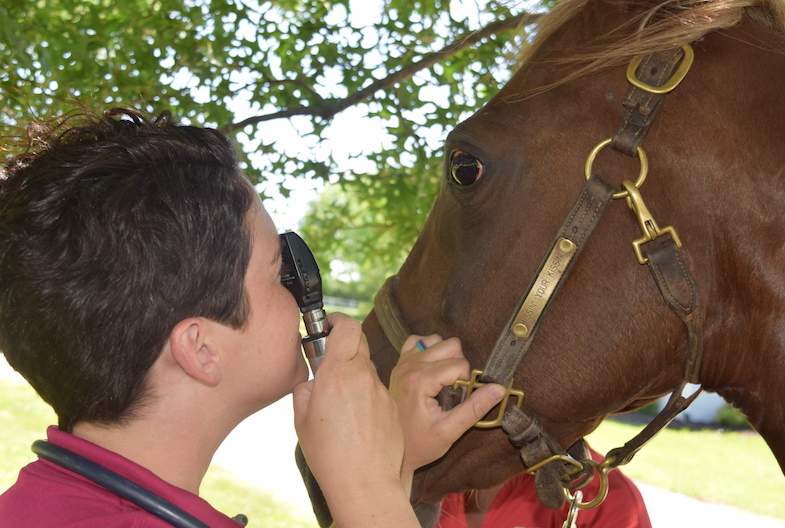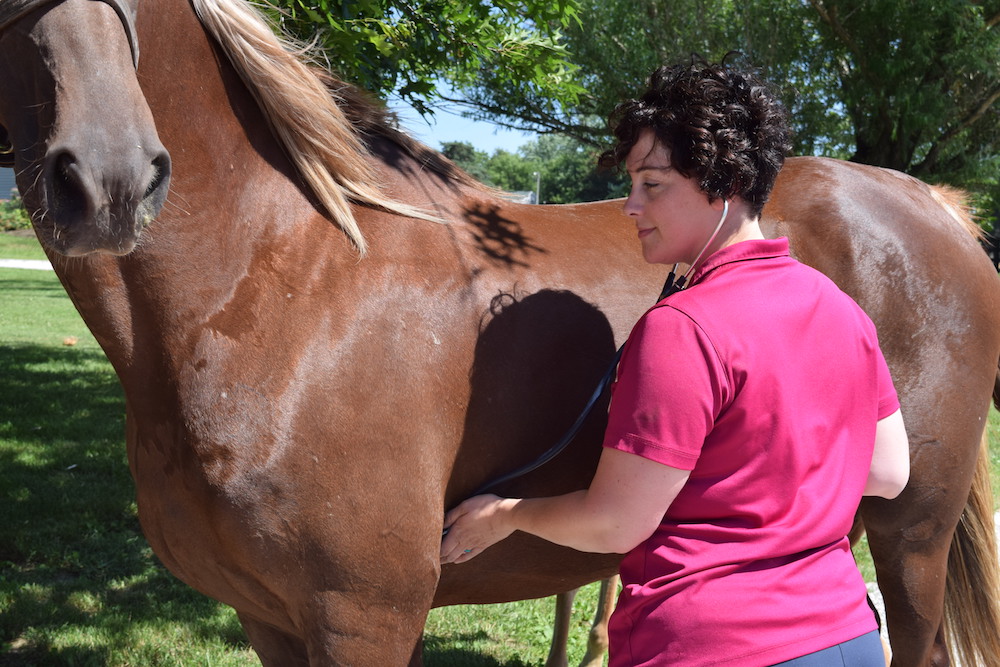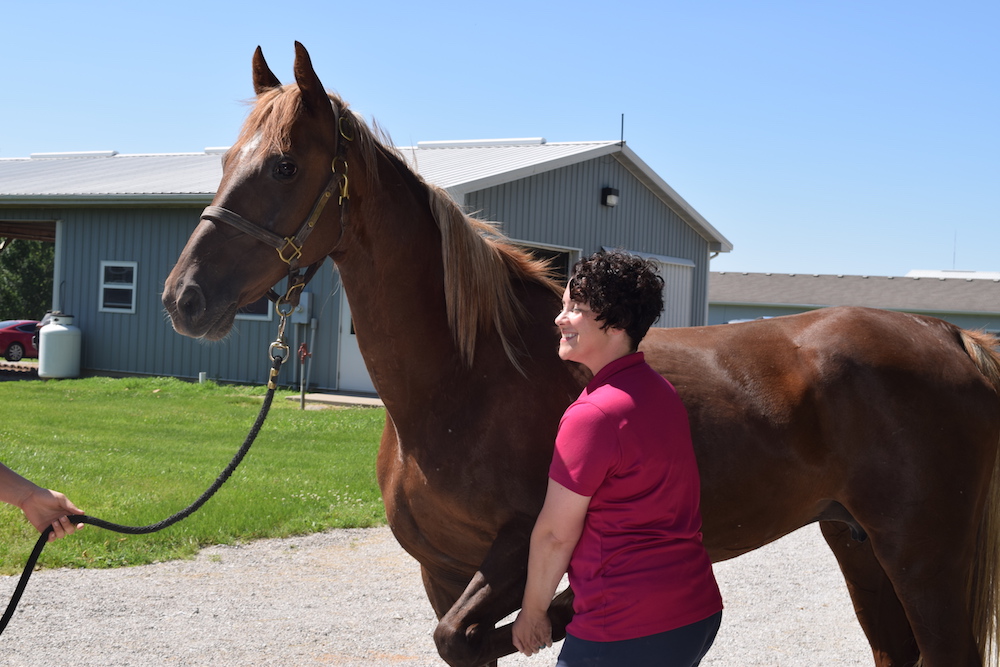 Finding your next equine partner conjures a mix of excitement and trepidation. You and your equine partner need to have the perfect chemistry. Finding the perfect partner is deeply personal, and the purchase of any horse should never be entered into lightly. Pre-purchase veterinary examinations can give you a better idea of the condition of the animal you are considering. You would never purchase a home without a thorough inspection; protecting your investment is of the utmost importance. The same can be said for purchasing your next equine partner. But what is involved in an in-depth pre-purchase exam?
Finding your next equine partner conjures a mix of excitement and trepidation. You and your equine partner need to have the perfect chemistry. Finding the perfect partner is deeply personal, and the purchase of any horse should never be entered into lightly. Pre-purchase veterinary examinations can give you a better idea of the condition of the animal you are considering. You would never purchase a home without a thorough inspection; protecting your investment is of the utmost importance. The same can be said for purchasing your next equine partner. But what is involved in an in-depth pre-purchase exam?
Definition
Pre-purchase exams are generally requested by the buyer at the buyers’ expense. The examination is a complete physical exam, which evaluates the horse from the nose to tail and everything in between and is also known as a “vet check.” The veterinarian assesses all aspects of the horse’s health and past medical history in an attempt to provide information on the future health and performance of the animal. The goal is to identify areas of concern, which may cause difficulties in the future. It is not a crystal ball, but an honest risk assessment.
It is important to note that a pre-purchase exam is not a guarantee of future health or soundness. It also does not guarantee the horse will perform well in its intended purpose. It only assesses the horse on that particular day and attempts to use exam findings and previous medical history to identify potential areas of risk to future health and soundness.
Selecting a veterinarian
The veterinarian performing the exam should be familiar with the breed and discipline of the horse. You are looking for someone to have an impartial opinion and educate you on the current health status of the horse for your intended purpose. Your primary veterinarian can assist you in selecting a veterinarian from any area outside your home base.
Past medical history
Previous medical history of the horse is very important. This part of the exam is at the mercy of the seller’s disclosure. Any reported previous illness, lameness and current medications should be noted. Any evidence of previous problems and potential long-term consequences or recurrences should be discussed in-depth with the buyer.
Physical exam
 The general physical exam starts at a distance. Age, breed, color and identifying marks are identified and confirmed. Body condition score is assessed using a 1-9 grading scale (1 being emaciated and 9 being super obese). Height and weight are estimated. Behavior and tractability are assessed based on the intended purpose; a yearling being purchased as a prospect may act very differently than an older horse intended for a youth’s horse.
The general physical exam starts at a distance. Age, breed, color and identifying marks are identified and confirmed. Body condition score is assessed using a 1-9 grading scale (1 being emaciated and 9 being super obese). Height and weight are estimated. Behavior and tractability are assessed based on the intended purpose; a yearling being purchased as a prospect may act very differently than an older horse intended for a youth’s horse.
Starting at the tip of the nose and working to the tail, the teeth are examined first. The teeth should be consistent with the age of the horse. Any dental misalignments, sharp points and other abnormalities are recorded. The eyes should be assessed for vision and any early warning signs for vision loss. Ears, skin and hair are also assessed. Gut sounds and evaluating manure quality gives insight to the digestive system health. External genitalia should also be clear of abnormalities. The horse’s vital signs are also obtained and recorded.
Cardiovascular and Respiratory Systems
The cardiovascular and respiratory systems are crucial for any athlete. The cardiovascular system includes the heart, blood and blood vessels. The heart should be thoroughly auscultated. Pulse quality and rhythm on multiple locations is assessed.
The respiratory system includes the nose, mouth, pharynx, larynx, trachea and lungs. The lungs, trachea and larynx should be auscultated. Externally the nostrils should be examined for any abnormal discharge and proper airflow. The larynx and trachea should be digitally palpated. Any abnormal noise, nasal discharge, or cough heard during the exam should be investigated further.
Hooves
External exam of the hooves should match the breed and discipline. For Saddlebred show horses, having appropriate shoeing is paramount. Digital pulse assessment and hoof tester exam should be performed on all four feet. Hoof testers can locate areas of subclinical tenderness. Abnormal digital pulses possibly indicate improper blood flow and disease within the foot.
Musculoskeletal System
A crucial part of being a successful show horse is being sound. A sound horse is one which has normal motion at all-natural gates. The horse should be appropriately muscled and have no areas of any swelling or atrophy. The muscles, tendons, ligaments and joints should be palpated. Any areas of heat, swelling, effusion, or tenderness to palpation warrants further investigation.
The patient should be observed in motion at all-natural gaits in straight lines and circling in both directions. How each veterinarian prefers to observe the horse in motion varies. Personally, I start with the patient moving on a lunge line or in lines in a circle; which one depends on the trainer and the horse. Some trainers prefer not to lunge horses with large shoe packages in place and some younger horses are too fresh on a lunge line to adequately assess soundness. My preferred method is on a lunge line without any tack, as this allows the horse to move as naturally as possible.
Following lunging or line work, I observe the horse traveling in hand. The horse is observed at a walk and trot in straight line. Following several baseline trips, I perform flexion tests. Flexion tests are defined as placing isolated sections of the limb in flexion, held for a brief period of time, and then having the horse trotted off. The horse is immediately scrutinized for any changes from baseline. The purpose of the flexion tests is to place certain areas of the limb under stress and identify areas of concern. Every veterinarian has different methods of grading responses. I grade flexion tests on a mild, moderate, and severe response score system.
 Flexion tests performed can include distal limb, carpus, hock and stifle flexion. Distal limb flexion can be performed on the fore and hind limbs. This is also known as the fetlock flexion; however, this is an inappropriate name for it, as it flexes more than the fetlock joint. The distal limb flexion stresses the fetlock, pastern, coffin joints and their associated soft tissue structures. The carpal (knee) flexion is performed on the forelimbs and stresses all three joints that encompass the carpus and the associated soft tissue structures. The hock and stifle flexion tests are hind limb specific. The hock flexion test is when the hind limb is brought into flexion by bringing the foot cranially (toward the head) and toward the belly. The stifle flexion test is when the hind limb is brought into flexion by moving the foot caudally (toward the tail) while lifting the limb up. The stifle flexion test is similar to the stance used by the farrier to work on the hind feet.
Flexion tests performed can include distal limb, carpus, hock and stifle flexion. Distal limb flexion can be performed on the fore and hind limbs. This is also known as the fetlock flexion; however, this is an inappropriate name for it, as it flexes more than the fetlock joint. The distal limb flexion stresses the fetlock, pastern, coffin joints and their associated soft tissue structures. The carpal (knee) flexion is performed on the forelimbs and stresses all three joints that encompass the carpus and the associated soft tissue structures. The hock and stifle flexion tests are hind limb specific. The hock flexion test is when the hind limb is brought into flexion by bringing the foot cranially (toward the head) and toward the belly. The stifle flexion test is when the hind limb is brought into flexion by moving the foot caudally (toward the tail) while lifting the limb up. The stifle flexion test is similar to the stance used by the farrier to work on the hind feet.
Flexion tests are useful tools to potentially detect areas of subclinical pain or disease, but they are not without fault. They are nonspecific and stress multiple areas and structures at once. The reciprocal apparatus of the hind limb means the entire hind limb is connected, so by flexing one region, the entire limb is also under some degree of flexion and stress. Additionally, a negative flexion test response (no change from baseline to moving post flexion test) does not necessarily mean there are no abnormalities in the region. Positive or negative flexion tests do not predict future soundness or unsoundness. They should only be used as a tool to identify possible areas of concern.
Available diagnostics
Additional diagnostic modalities may be utilized as part of the pre-purchase exam to provide a more comprehensive screening. Additional options include radiographs, upper airway endoscopy, ultrasound, bloodwork, drug screen and breeding soundness examination. Which additional diagnostics are utilized is at the discretion of the buyer, veterinarian and intended purpose. A breeding ultrasound, uterine culture, and uterine biopsy may be important diagnostics prior to purchasing your next broodmare, but unnecessary (not to mention impossible) for a gelding youth show horse. Any abnormalities discovered during the thorough examination may necessitate additional testing to determine a possible cause or severity of an abnormality.
Finding your next equine partner is definitely stressful, but you can remove some of the stress by protecting your investment with a thorough veterinary pre-purchase examination. While it can’t provide a guarantee or warranty on a horse’s future health, soundness or behavior, it can give you a better idea of the condition of the animal you are considering. And without a crystal ball, it’s the next best thing. As in anything, looking before you leap ensures a kinder landing.
Photos by Kendall Enright, DVM.



